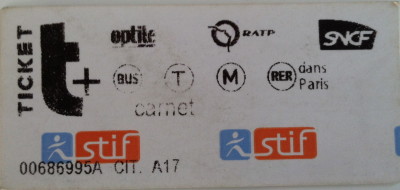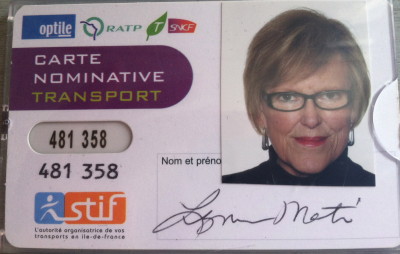Get on Le Bus, Gus!

Last year, when we were in Paris for a month, we never boarded a bus because we were intimidated. We have always been able to master the subway system because it’s relatively easy for visitors to understand. But the bus is a whole different animal. It’s so complicated that a lot of locals we have met won’t even try it, but this year we had no choice.

On the subway, we can make mistakes without anyone knowing it. Below the earth, as long as a person has a little white cardboard ticket that the machine sucks up and then spits out at the top, the turnstile will open. This allows the passenger to enter the system and ride around all day long taking the wrong line and ending up on the wrong side of Paris without anyone being the wiser. We’ve been known to get on the Métro in the wrong direction, but please don’t tell the children. They will be alarmed.
People on the Métro seem to maintain a personal barrier even when they’re smashed together intimately. But on the bus everyone can see our stupid mistakes as we fumble at the top of the front steps, trying to figure out how to pay, and then locate a seat or at least a pole to grab to avoid rolling down the aisle when the vehicle lurches forward or stops suddenly. Then, once aboard, there are protocols, some of which are not visible, some of which are posted in French, which we can’t read. All locals understand both the implied and printed rules and they are enforced diligently by passengers. For instance, it takes quite a while to learn that particular seats are set aside for children and pregnant women. An able-bodied man who sits in one can be the recipient of a brand of deadly stink-eye that only the French know how to administer. The women are the most adept at that look, which combines a wrinkle in the nose indicating that she smells something worse than tires burning in the middle of the bus and an eyebrow raised so dramatically that her perfectly coiffed hair becomes even more lofty. An almost imperceptible shake of the head (the tsk tsk one), completes the gesture. It’s fascinating to witness!

Last year, we covertly watched people at the bus stops for clues. People queued up and entered toward the front of the bus, while others departed from the back. Everyone moved briskly and knew exactly what they were doing. We hung back and never tried it because we had no idea how much money we would need, where to get tickets, and the maps at the bus stops were incomprehensible to us. Being linguistically challenged, we knew there was little hope of getting help from other passengers or the driver. Bus drivers have always intimidated me, so I wasn’t in a position to ask for help in any language. I’m afraid of librarians, too. Makes me wonder what went on in grade school that I’ve sublimated.

This year, our apartment is a long walk from the Metro station, especially when it’s raining. The bus stops outside our door and takes us to the Métro in about five minutes, thus opening up all of Paris for us. We were forced to cowboy up and figure out the system within the first few days of arriving because the extra walk to and from the Métro made our excursions seem too long.
Here’s is what we learned:
Step 1: acquire the ticket (or monthly pass, which we now proudly own). Tickets may be bought in packets of ten and the little white stubs end up in every pocket, purse, drawer and suitcase you own eventually. Since we intend to spend a lot of time in Paris in the coming years, we opted for the Navigo Pass. These hard plastic cards require a head shot photo (no head covering, please), and take quite a bit of time to acquire, even with a helpful attendant at a Metro station. The attendant who helped us gravely accepted our photos, produced a pair of scissors to trim the pictures to exactly the right size, ceremoniously glued them onto our passes, and inserted them into space-age indestructible plastic gizmos which are intended to last through ten years of daily abuse as they are smacked against the electronic eyes at bus and subway terminals. The owner fills them up with euros once a month and they are good for the Metro, the RER (Paris railway), trams and subway.

2: if you have a smart phone you can download the Métro and bus route program which will help you plot your course. If you don’t have a smart phone, I have no earthly idea how you would figure it all out. Once you have arrived at the stop you need, get on the bus. This may sound simple, but in Paris, lining up is another mysterious exercise, whose fluid rules mystify even the most astute outsider. People will first approach the bus shelter, crane their heads around the side to see the electronic ticker which indicates when the next one will arrive, then range around one another in a loosely tiered fashion, the people who arrived first being closer to the curb. There is NEVER a straight line, or queue, as there is in Britain and other more uptight societies. When the bus does arrive, the casual line-up disintegrates. You must step lively, jump on the thing the instant there’s enough floor space between peoples’ shopping bags, large purses, strollers, wheelchairs, and briefcases, to plant your feet, and grab a solid object before the doors shut with their pneumatic hiss and you wind up thrown against your neighbor’s body, or worse, his brick-filled backpack. The national French sport is cutting in line, and a lifetime of practice gives them a definite edge on newcomers.
Step 3: Hang on tight and if you can, get a seat, but be careful that you take the right one or the unkind responses will remain in your memory long after the bus ride itself has faded. I am so unaware of my own elderly status that I sometimes feel as if I should jump up to give my seat away to an older woman and then I realize that I’m older than she is and I sit back down. Being a gentleman, Tim has a really hard time remaining seated while there are any females at all standing in the aisles, but I think he’s getting over it.

Step 4: watch the orange electronic sign on which crawls the ultimate destination of the bus and its interim stops. On some runs a recorded voice will announce the stops, which is a nice bonus, a French pronunciation lesson for those of us trying to understand the language.
Step 5: get off the bus. Refer to Step 2. The same rules apply. Stepping over buggies, canes, feet and dodging back packs and even lumber (honestly) can add to the thrill of this kind of transportation and line-cutting is practiced even in those cramped conditions. Keeping a good grip on your sense of humor at these times is essential!
Step 6: find a nearby bistro, commandeer a table and order yourself something cool and delicious while you celebrate your victory over the Paris transit system. After all, you’re practically a native now!




I forgot to mention that when I boarded the bus I sat down in a handicapped seat. As soon as I realized my faux pas I moved quickly to another seat but not without thinking of you. LOL. Jack
Lynne, we mastered the bus the first day riding from near our hotel to Montemartre for our walking free walking tour. Today we used the Metro to get from Gare de L’est to Notre Dame for another walking tour. We followed that up with a river cruise. Even returning after dinner and wine near St. Michaels fountain was pretty easy. We are so proud of ourselves and loving Paris. Oh BTW we took the train from CDG to Gare du Nord and walked to our hotel.
Do you care to share the details on the apt u rented in Paris. Jack Marquette jacsan_3 @ yahoo.com
Hi, Lynne,
Enjoyed your reflections on riding a bus in in Paris. We were there two months last year and there are two wonderful websites you might find useful:
(1) http://www.ratp.fr/plan-interactif/cartebus.php… This site has maps, timetables, stops, etc.
(2) ratp.fr/itineraires/en/ratp/recherche-avancee This Trip Planner page has advanced options/filtering available and if you want only bus information, just select bus/tram only. It’s pretty detailed information and makes the bus experience far less intimdating.
Have a wonderful summer and fall.
Beverly Johnson
Lynne,
Thanks for the recent update, loved it & congrats to you & Tim on conquering the bus! Sad that you are leaving Paris but it has been three wonderful months & you will be back.
Know exactly how your felt regarding the etiquette, etc. regarding the different forms of transportation in various countries. Lowell & I were very lucky to have our good friend, Mark who happens to be an actuary, figure out all of the metro stops quickly & precisely on our Paris stay in May. He informed us of the stop we were starting with & the stop to get off (even how many more stops before ours), we obeyed, no problems. It can be very daunting but also a fun experience, minus the pick pockets. Can’t wait to return & try the bus the next visit.
Happy travels, looking forward to hearing about Berlin.
I’ve enjoyed your articles from Paris, since I will be there in a few weeks. Hopefully walking, bikes and the metro will serve my transportation needs, but if I do venture on the bus system, I will be more informed. The fewer “deadly stink eye” experiences, the better !
Seriously, your humorous and very descriptive writing keeps me wanting more! My first trip to Paris and countryside France, also showed me how to “GET the HECK ON and GET the HECK OFF” the metro without hesitation, much like your bus story. The next trip to France, I took hubby and warned him about the “Get the heck on and Get the heck off” concept and how closing metro doors waits for no one! I know, deep down, he thought I was just being my usual analytical/Virgo (what a combo!) self and didn’t listen to me. As the Metro arrived, he did the gentleman thing and let others get on while I quietly, and with grace, RACED onto the Metro…he almost didn’t make it on! He looked at me and said “The war is over, right?” I said, “Not when it comes to getting on/off the Metro.”
We are just now empty nesters with a 2 year old grandson and a granddaughter due in October…so our trips abroad are only 2 weeks long. But one of these years, we plan for me to retire first (ha ha!) because hubby can work from anywhere, as long as there is Internet or a mobile device of some kind.
Really appreciate your blog, helpful hints, straightforward information and humor!
Bon voyage!
In Paris back in 2001, I managed the bus system to get to the large open air market! It was fantastic, crowded, and I loved every minute of it. Furthermore, I was proud of myself for getting on the bus solo. Your story reminded me of that trip. Thanks for sharing!
we have previously communicated. you had said how you and Tim did not like Buenos Aires at all — perhaps you never took the buses there. Like the UK there is order.. People line up – some stops have more than one bus which might stop there so sometimes difficult to figure out who is for what bus but they step aside if the bus coming is not for them. The seats in the front of the bus are for the elderly and pregnant women but also for women with children. Often times I get on board and these seats are occupied by very young people. They play with their texting avoiding eye contact. Perhaps if I said in Spanish I wanted their seat I might get it but I sometimes doubt it. Few will give up the seat for any reason unless some old lady or man with a cane indicates for them to move along. I am almost your age. The buses lurch one way and the next. They fill them to capacity. France sounds better in that they give you a monitor to show where they are along their routes. BA you have to know where you are to get off at the proper place. BA does offer on line the various routes. If you have a smart phone then you can figure out where you are at any point in time. I do not have one at this time.
Perhaps next year I will be in France again. I have done the Metro system there which is okay but there is often times a lot of walking underground there too. I appreciate your article here. I have never read one like it at all. You spell things out very fine indeed.
Perhaps with all of your travels you could explain to me the smart phones; the plans; the costs and the like. It would be wonderful to understand what to have there. Bringing an unlocked phone; getting the proper SIM cards which must differ throughout the country too. Well I am sure you got the picture of what I am seeking and you can discuss the same subject for other countries too. I would think others around would appreciate this data too.
Your writing is very good
You told me you have an upcoming book. Please let me know when it might be in print. I would enjoy reading it.
all my best
Walter
Love reading your posts! Your adventures on the
metro reminded me of our own Paris adventures 30 years ago when we got on the metro going the wrong way. Thanks for the laughs!
Your latest highly entertaining article about Paris buses reminded me of a similar adventure that my son and I had in Varese, Italy back in 2004. When my Italian-American husband took us along on his business trip, we decided to take the bus into town from our lakeside hotel one afternoon while he was at work. Neither of us spoke any Italian, but felt confident that with the tickets given us by our concierge and directions to the bus stop, everything would work out. It eventually did, but the experience has provided us with shared memories of the “what were we thinking?!” variety ever since. And perhaps it contributed to my son’s decision to take Italian in college 🙂 I have also traveled to unexpected and unintended destinations several times on the Metro – and must say that Italians are generally much more likely to try to assist clueless American travelers than the French! I especially loved your description of the scornful expression given to those who do not measure up to accepted norms of Parisian bus etiquette. We experienced a similar look (shock and consternation) from the passengers on the local Varese bus when they discovered that we were NOT Italian. This happened when we started wondering aloud how we would know when we reached the city center. Something we should have considered before boarding, but “Que sera sera” was and often still is my favorite traveling motto. Hilarity often ensues. Don’t get me started on Italian trains…
I so look forward to your posts! Keep them coming, please!
Lynne,
We are so enjoying your adventures. You are an inspiration to my husband and myself and we already have plans to follow in your footsteps in less than 2 years…with a few memorable vacations in the meantime. We will be in Burgundy for a week mid August, with a few days in Loire, Normandy, and then back to Paris for a few days. I wish this trip coincided with your duration in Paris so we could meet up to share a bottle of wine. We have been traveling to France for the past few years exploring Provence, Loire, Dordogne, and others. Living there for a few months a year is not hard to imagine. Cheers to you both. Keep the fantastic stories coming.
Kathy
PS looking for tips on the most economical way to obtain data roaming for iPhone in Europe. Do you just sign up for a plan when you are there?
The buses in Norway seem easier than you describe 🙂 thank goodness!
My crystal ball just revealed a month in Paris one day. What will the addition of French do to my Italian and Spanish? They don’t mind their place very well as it is.
Merci Lynne: I’ve been to Paris 4 times and I have never had the nerve to take the metro let alone a local bus! I admire your tenacity and appreciate your willingness to share your knowledge with the less adventurous traveler. I enjoy your site and I am always giddy when I see a new message. Enjoy!
Lynne & Tim! LOVED this update, and the comments. Can’t wait to do some “winin’ ” with you when you get back. In the meantime, you’re either “on the bus” or “off the bus” as the expression goes. Our respective hats are off to you, as usual.
Love,
(Madame et Monsieur) Deb & Bill
I love it! It can be intimidating. But fake it till you make it works, too. Move along with authority, like you know what you are doing. Then clandestinely look at the bus stop poster on the wall to spy out your stop and make sure you don’t miss it. Pretty soon you will be an expert! You are already official with your plastic 10-year ID! I do miss Paris!
Nice piece… I really enjoyed reading it. But since I hope to travel to Paris soon I am easily intimidated by possible humiliation and I would love to be able to get around on the buses, I do have a couple of questions about stuff you left out. 1) WHERE do you buy the tickets? 10-packs? Are single tkts available? Where/how? 1) Once you get on the bus, what do you do with that ticket? Do you give it to the driver, put it in a machine like the Metro? Or? 3) I understand the importance of not sitting in the wrong seat, but WHICH seats are the ones to avoid? 4) When you get to your stop, is there a bell or something you need to ring to tell the driver you want to get off?
I’m enjoying following your adventures…. Thanks.
Aw shucks, guys. I guess I forgot to tell you that we’re actually in the Witness Protection Program! 🙂
I’m so pleased that you’re enjoying this site. I didn’t even tell you about being on one of those runaway buses during one of the many demonstrations that go one here. I will do that soon because it was pretty funny!
Thanks to all for responding!
Lynne……you’ve already blown your cover as a spy announcing it on your blog so perhaps you could switch to being a librarian as you look more like you are shushing somebody talking or admonishing an overdue borrower. I can imagine your trepidation at boarding a bus for which you have no clear idea of its route or even the direction it is going and unable to read or ask for directions especially from often less-than-helpful local sources. My experience on strange transit systems is often made less frightening by studying maps for homework and then trying desperately to seek confirmation of where the hell I am or which direction I am going by trying to check for landmarks or obscure street signs IF I can see them out the window. Jockeying for a viable position so I can see out a window is a whole other experience in international relations in which you risk offending natives by invading their personal space as you attempt to peer past their faces and hope they don’t think you are trying to make some kind of weird eye contact.
Your last picture on your way to drink wine with friends begs the question: Should you be heeding a warning, not about avoiding operating heavy machinery after consumption, but about avoiding trying to board and navigate heavy machinery after consumption? Your next entry topic could be sharing with us how different it is returning home on the bus after wining the afternoon away. Or by that point, do you really care what happens?
I know, I know, I know! My feelings exactly- re: item 3. The first time it happened to me, I thought the young man was just getting off the bus- then I realized I must actually look older than I feel! Anyhow, a seat’s a seat, so I got over it. The confusion abounds regarding buses and then,
just when you think you’ve figured it out, there’s a DETOUR and now you are off the “known path” and who knows where! And you cannot ask a question! We just returned from Russia and I had printed a transit map with “our” stop circled. This, plus a lots of charades, helped somewhat! But those travel experiences are why we do it!
My feelings exactly! I’ve been to Paris multiple times but still am intimidated by the bus system. I CAN read those route signs at the bus stops (and they’re available for printing online) so if I just want to find out which bus goes directly to where I’m headed – no problem. But I’ve never been brave enough to change buses, or even to figure out how to do that. Thanks for the notes about “unwritten rules.” I hope to manage the bus system one day! I have one somewhat funny bus story: A friend and I were staying in an apartment in the 10th Arr. and went over to the Tour Eiffel to see the light show our last night. At about 10:30pm we headed home on the Metro, needing to change lines along the way. When we reached the change point, there was a phalanx of policemen blocking the way. They said our intended line was closed due to an accident and they directed us up to the street to catch a bus. Not knowing much French, I misread the route sign to say that the bus we needed (#26) stopped running after 10 pm. So we headed to a taxi stand to try to get “home.” As we were walking I glanced behind us for open taxis and saw a #26 bus, so we ran to the bus stop and got on. But since it was our last day, I had used my last ticket on the Metro and my friend only had one left. The bus driver would not take my 20 euro bill (the only thing I had left), but we scrounged around in our purses and finally came up with the fare. I (sort of) asked the bus driver when we would be at our stop and he pointed behind him (we’d passed it!). So he stopped the bus in the middle of the block (NOT at a bus stop), opened the front doors, where we were still standing, and gestured for us to GET OFF! Luckily we were only a couple of blocks from our apartment. It makes a great story now but was hugely embarassing then.
I enjoy all your essays, but this one was so funny – it could be a scene out of a Pink Panther movie 🙂 For someone who lives in a small town in the southwest corner of New Mexico, it’s fascinating to read about your adventures and to have the opportunity to enjoy experiencing them vicariously. It’s always a treat when I find your email in my Inbox!
Congratulations on braving the Paris bus system! Have you tried the Velib bikes yet? During our extended Paris stay they were a great way to get around, in good weather mind you. Enjoy the rest of your Paris summer, we are all envious :o)
Yes, you do look like a spy! Wouldn’t have thought of it. That’s hilarious.
Thanks for the tutorial.
All part of the total French experience to learn and enjoy – Bravo!